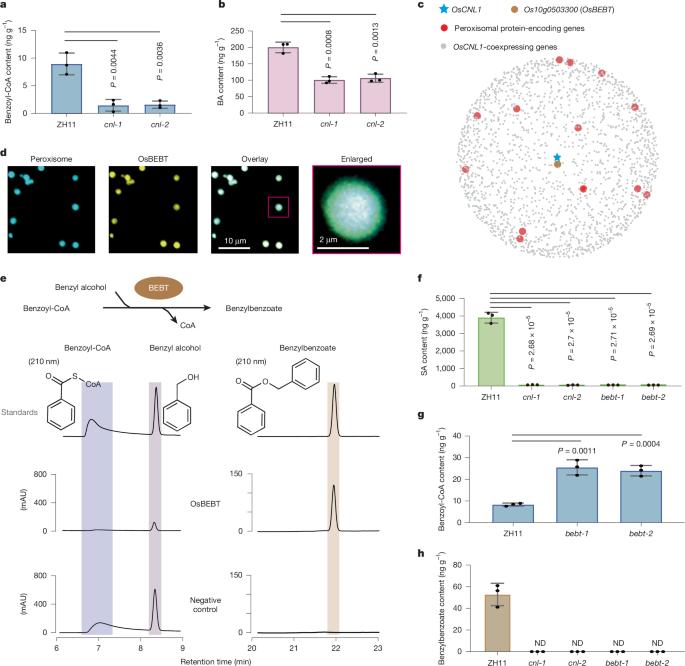植物苯丙氨酸衍生水杨酸的生物合成解译。
IF 48.5
1区 综合性期刊
Q1 MULTIDISCIPLINARY SCIENCES
引用次数: 0
摘要
水杨酸(Salicylic acid, SA)是一种普遍存在的植物激素,在人类文明中有着悠久的历史1,2。由于SA在协调植物病原体防御中的核心作用,了解SA的生物合成是植物免疫研究和作物改良的基础。在拟南芥中,异chorisate衍生的SA生物合成已经得到了很好的定义。然而,越来越多的证据表明,苯丙氨酸衍生的SA在许多其他植物物种中具有重要的生物合成功能。本研究揭示了苯丙氨酸衍生的SA在水稻中的生物合成途径,通过鉴定了三种专用酶-过氧化物异构体苯甲酰辅酶a:苄基醇苯甲酰转移酶(BEBT)、内质网相关细胞色素P450酶苯甲酰苯甲酸羟化酶(BBH)和胞质苯甲酰水杨酸酯酶(BSE),它们依次将苯甲酰辅酶a转化为苯甲酸苄酯、苯甲酸苄酯和SA。该三酶模块的病原菌诱导基因表达模式和SA生物合成功能在多种植物中是保守的。这项工作填补了一种关键植物防御激素生物合成方面的重大知识空白,为创造抗病作物的新策略奠定了基础。本文章由计算机程序翻译,如有差异,请以英文原文为准。

Deciphering phenylalanine-derived salicylic acid biosynthesis in plants
Salicylic acid (SA) is a ubiquitous plant hormone with a long history in human civilization1,2. Because of the central role of SA in orchestrating plant pathogen defence, understanding SA biosynthesis is fundamental to plant immunity research and crop improvement. Isochorismate-derived SA biosynthesis has been well defined in Arabidopsis. However, increasing evidence suggests a crucial function for phenylalanine-derived SA biosynthesis in many other plant species1. Here we reveal the phenylalanine-derived SA biosynthetic pathway in rice by identifying three dedicated enzymes — peroxisomal benzoyl-CoA:benzyl alcohol benzoyltransferase (BEBT), the endoplasmic reticulum-associated cytochrome P450 enzyme benzylbenzoate hydroxylase (BBH), and cytosolic benzylsalicylate esterase (BSE) that sequentially convert benzoyl-CoA to benzylbenzoate, benzylsalicylate and SA. The pathogen-induced gene expression pattern and SA biosynthetic functions of this triple-enzyme module are conserved in diverse plants. This work fills a major knowledge gap in the biosynthesis of a key plant defence hormone, establishing a foundation for new strategies to create disease-resistant crops. Diverse plant species synthesize salicylic acid from phenylalanine through a pathway that includes a conserved triple-enzyme module that converts benzoyl-CoA to salicylic acid.
求助全文
通过发布文献求助,成功后即可免费获取论文全文。
去求助
来源期刊

Nature
综合性期刊-综合性期刊
CiteScore
90.00
自引率
1.20%
发文量
3652
审稿时长
3 months
期刊介绍:
Nature is a prestigious international journal that publishes peer-reviewed research in various scientific and technological fields. The selection of articles is based on criteria such as originality, importance, interdisciplinary relevance, timeliness, accessibility, elegance, and surprising conclusions. In addition to showcasing significant scientific advances, Nature delivers rapid, authoritative, insightful news, and interpretation of current and upcoming trends impacting science, scientists, and the broader public. The journal serves a dual purpose: firstly, to promptly share noteworthy scientific advances and foster discussions among scientists, and secondly, to ensure the swift dissemination of scientific results globally, emphasizing their significance for knowledge, culture, and daily life.
 求助内容:
求助内容: 应助结果提醒方式:
应助结果提醒方式:


